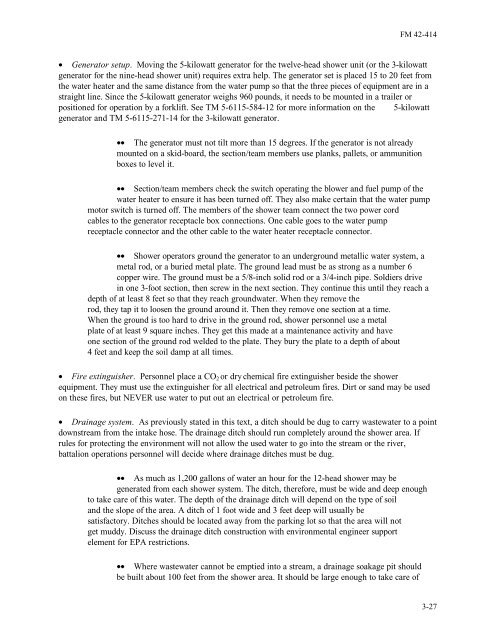Tactics, techniques, and procedures for - Army Electronic ...
Tactics, techniques, and procedures for - Army Electronic ...
Tactics, techniques, and procedures for - Army Electronic ...
You also want an ePaper? Increase the reach of your titles
YUMPU automatically turns print PDFs into web optimized ePapers that Google loves.
FM 42-414<br />
• Generator setup. Moving the 5-kilowatt generator <strong>for</strong> the twelve-head shower unit (or the 3-kilowatt<br />
generator <strong>for</strong> the nine-head shower unit) requires extra help. The generator set is placed 15 to 20 feet from<br />
the water heater <strong>and</strong> the same distance from the water pump so that the three pieces of equipment are in a<br />
straight line. Since the 5-kilowatt generator weighs 960 pounds, it needs to be mounted in a trailer or<br />
positioned <strong>for</strong> operation by a <strong>for</strong>klift. See TM 5-6115-584-12 <strong>for</strong> more in<strong>for</strong>mation on the 5-kilowatt<br />
generator <strong>and</strong> TM 5-6115-271-14 <strong>for</strong> the 3-kilowatt generator.<br />
•• The generator must not tilt more than 15 degrees. If the generator is not already<br />
mounted on a skid-board, the section/team members use planks, pallets, or ammunition<br />
boxes to level it.<br />
•• Section/team members check the switch operating the blower <strong>and</strong> fuel pump of the<br />
water heater to ensure it has been turned off. They also make certain that the water pump<br />
motor switch is turned off. The members of the shower team connect the two power cord<br />
cables to the generator receptacle box connections. One cable goes to the water pump<br />
receptacle connector <strong>and</strong> the other cable to the water heater receptacle connector.<br />
•• Shower operators ground the generator to an underground metallic water system, a<br />
metal rod, or a buried metal plate. The ground lead must be as strong as a number 6<br />
copper wire. The ground must be a 5/8-inch solid rod or a 3/4-inch pipe. Soldiers drive<br />
in one 3-foot section, then screw in the next section. They continue this until they reach a<br />
depth of at least 8 feet so that they reach groundwater. When they remove the<br />
rod, they tap it to loosen the ground around it. Then they remove one section at a time.<br />
When the ground is too hard to drive in the ground rod, shower personnel use a metal<br />
plate of at least 9 square inches. They get this made at a maintenance activity <strong>and</strong> have<br />
one section of the ground rod welded to the plate. They bury the plate to a depth of about<br />
4 feet <strong>and</strong> keep the soil damp at all times.<br />
• Fire extinguisher. Personnel place a CO2 or dry chemical fire extinguisher beside the shower<br />
equipment. They must use the extinguisher <strong>for</strong> all electrical <strong>and</strong> petroleum fires. Dirt or s<strong>and</strong> may be used<br />
on these fires, but NEVER use water to put out an electrical or petroleum fire.<br />
• Drainage system. As previously stated in this text, a ditch should be dug to carry wastewater to a point<br />
downstream from the intake hose. The drainage ditch should run completely around the shower area. If<br />
rules <strong>for</strong> protecting the environment will not allow the used water to go into the stream or the river,<br />
battalion operations personnel will decide where drainage ditches must be dug.<br />
•• As much as 1,200 gallons of water an hour <strong>for</strong> the 12-head shower may be<br />
generated from each shower system. The ditch, there<strong>for</strong>e, must be wide <strong>and</strong> deep enough<br />
to take care of this water. The depth of the drainage ditch will depend on the type of soil<br />
<strong>and</strong> the slope of the area. A ditch of 1 foot wide <strong>and</strong> 3 feet deep will usually be<br />
satisfactory. Ditches should be located away from the parking lot so that the area will not<br />
get muddy. Discuss the drainage ditch construction with environmental engineer support<br />
element <strong>for</strong> EPA restrictions.<br />
•• Where wastewater cannot be emptied into a stream, a drainage soakage pit should<br />
be built about 100 feet from the shower area. It should be large enough to take care of<br />
3-27

















